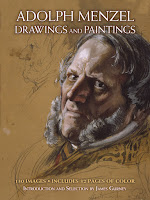Should an artist's physical appearance matter, or should we consider only the work? I suppose one's appearance only matters if it affects his work or his outlook on life. And in Adolph Menzel's case his unique form certainly shaped his personal and artistic choices.
Adolph Menzel (1815-1905) was conspicuously small in stature, only four feet, six inches tall. He had a large head and was often compared to a gnome. He frequently scowled. When he was young, his peers called him the “Little Mushroom.” When he became angry and fought back, they called him the “Poisonous Mushroom.”
 |
Adolph von Menzel in his studio before a screen,
with his left hand drawing in a sketchbook. 1904.
|
His unusual stature affected his life from his early days. Reflecting on his art education, he said, “It would have been quite useful for me to have attended the Academy longer; only that, you know, a certain pride stood in the way: one pitied the cripple—the small one was smiled at. I sensed that strongly my whole life long, most strongly in my youth.” Although he was beloved by his circle of close friends and relations for his intelligence and wit, he spoke gruffly to strangers, not wanting to endure their condescension. He was extremely devoted to his family, especially his sister, brother and nephew.

In his self-portraits he regarded himself warily and uncomfortably. He did not like writers of his day to recount anecdotes about him, and urged them to “Please leave aside everything personal.” While reviewing galley proofs of a book of his artwork, he wrote marginal corrections full of sarcastic remarks about those “jackasses, the gentlemen of pen and ink.”
He kept to himself and never married. “Not only have I remained unmarried, throughout my life I have also renounced all relations with the other sex,” he wrote in his last will and testament. . . .There is a lack of any kind of self-made bond between me and the outside world.” There are few portrayals of female nudes in his life work.
 |
Boy with water glass. 1889. Pencil on paper. 20.8 x 13.3 cm. [8.2 x 5.2 in.]
Photo: © Karen Bartsch, /Villa Grisebach, Berlin
|
His alienation shaped his artistic outlook. One drawing might show a man sitting on a toilet or the patterns of an old man’s chest hair. At the same time, paradoxically, his drawings evince a remarkable empathy, particularly for people who were old, poor, or suffering. He was fascinated with frankly chronicling the physiognomies of his fellow humans.
Nobility often lies hidden behind unglamorous appearances. He once said, “A person not only acts with, but also has, a certain external appearance, and the latter is as inconsequential as it is accidental.”
In his mature years he had a studio on the fifth floor, where models would come in small groups and talk informally. Gustav Kirstein wrote that “on the landing one could encounter old, ugly models, ‘character heads,” which he preferred for practice in those late years.

The images in this post and the text are excerpted from my new book
Adolph Menzel: Drawings and Paintings. The book contains 130 images, including 32 pages of color.
The book is available signed from my website. Here's
the link if you'd like to order a signed copy. It's also available on
Amazon
.






